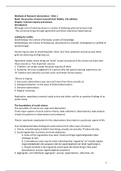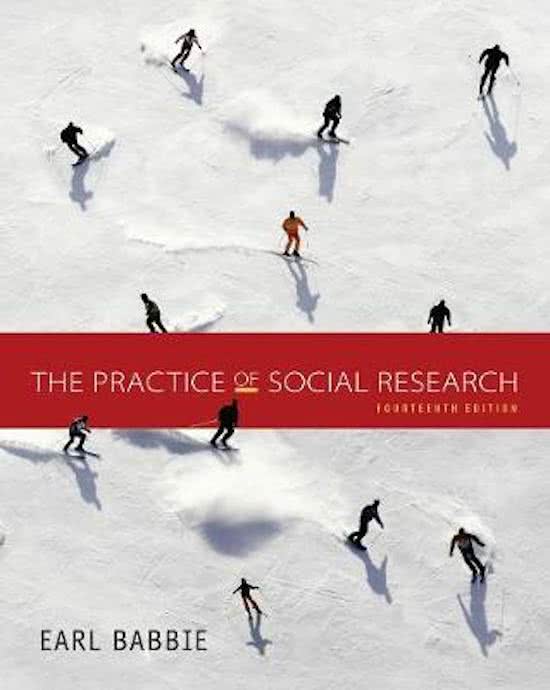Methods of Research Intervention – Blok 1
Book: the practice of social research (Earl Babbie, 14e edition)
Chapter 1 Human inquiry and science
Introduction
Although most of what we know is a matter of believing what we’ve been told.
- We can know things through agreement and direct experience (observation).
Looking for reality
Epistemology: the science of knowing: system of knowledge.
Methodology: the science of finding out; procedures for scientific investigation (a subfield of
epistemology).
Human inquiry aims at answering both ‘what’ and ‘why’ questions and we pursue these
goals by observing and figuring out.
Agreement reality: those things we ‘know’ as part and parcel of the culture we share with
those around us. Two important sources:
1. Tradition: we simply accept the great majority of them.
2. Authority: we trust a judgement of a person who has special training, experience, etc.
à Tradition and authority can both assist and hinder human inquiry.
!!Errors in inquiry:
1. Inaccurate observations (you see much more then there actually is).
2. Overgeneralization: on the basis of limited observations
3. Selective observations
4. Illogical reasoning
Replication: repeating a research study to test and either confirm or question findings of an
earlier study.
The foundations of social science
The two pillars of science are: logic and observation.
Three major aspects of social science: theory, data collection (=observations), data analysis
(=looks for patterns in observations and compares).
Theory: systematic explanation for the observations that relate to a particular aspect of life.
Four fundamental ideas distinguish social science from other ways of science:
1. Theory, not philosophy of belief: how things actually are and why à what and why.
2. Social regularities, but there are three objections:
A. Some of the regularities may seem trivial (sommige regelmatigheden lijken
alledaags te zijn).
B. Contradictory cases may be cited, indicating that ‘regularity’ isn’t totally regular
(tegenstijdigheden die aangeven dat de regelmatigheid niet altijd regelmatig is).
C. People involved in the regularity could upset the whole thing if they want
(betrokkenen kunnen regelmatigheid ontzetten).
3. Aggregates, not individuals: aggregate = groups, organizations, collectives, etc.
1
,4. Concepts and variables
Attributes: characteristics of people or things.
Variables: logical set of attributes.
Variable Attributes
Age Young, middle-age, old
Gender Male, female
Social class Upper, middle, lower
Independent variable: variable with values that are not problematic in an analysis but are
taken as simply given. Determine a dependent variable.
Dependent variable: variable assumed to depend on or be caused by another.
Three main purposes of social research
- Exploratory: research maps out a topic that may warrant further study later.
- Describing: the state of social affairs.
- Explanatory: providing reasons for phenomena in the form of causal relationships.
Some dialectics of social research
The is no one way to do social research. Four broad distinctions are made:
1. Idiographic and nomothetic explanation
Idiographic: an approach to explanation in which we seek to exhaust the idiosyncratic causes
of a particular condition or event. Imagine trying to list all the reasons why you chose to
attend your particular college. Given all those reasons, it’s difficult to imagine your making
any other choice (idio means unique, the scope of our explanation is limited to the single
case at hand).
à seek to explain a phenomenon as completely as possible (explaining why a particular
woman voted as she did).
Nomothetic: an approach to explanation in which we seek to identify a few causal factors
that generally impact a class of conditions or events. Imagine the two or three key factors
that determine which colleges students choose – proximity, reputation, and so forth.
à attempt to explain a broad range of phenomena at least partially (identifying a few factor
that account for much voting behavior in general).
à One more example: some studies focus on the full experiences of individuals as they live
their lives, whereas other studies look for statistical patterns describing the elderly in
general.
Gerontology: studying the elderly.
2. Inductive and deductive theory
Induction: the logical model in which general principles are developed from specific
observations à move from the particular to the general.
Deduction: the logical model in which specific expectations of hypotheses are developed on
the basis of general principles à move from the general to the specific.
2
,3. Determinism versus agency
The underlying logic of traditional science implicitly suggests a deterministic cause-and-
effect model in which individuals have no choice, although researchers do not say, nor
necessarily believe, that.
Some researchers are intent on focusing attention on the “agency” by which the subjects of
study are active, choice-making agents.
Tolerance for ambiguity: the ability to hold conflicting ideas in your mind simultaneously,
without denying or dismissing any of them.
4. Qualitative and quantitative data
Qualitative: richness of meanings.
Quantitative: numerical, makes our observations more explicit, statistical analyses.
à Both methods are useful and legitimate in social research.
Qualitative data aligned with idiographic explanations.
Quantitative data aligned with nomothetic explanations.
3
, Chapter 2 Paradigms, theory and social research
Introduction
Theories functions in three ways in research:
1. Prevent our being taken in by flukes (gelukjes).
2. Theories make sense of observed patterns in a way that can suggest other possibilities.
3. Theories shape and direct research efforts, pointing toward likely discoveries through
empirical observations (gericht op ontdekkingen door empirische observaties).
Theory relates directly to ‘why’ questions. Whereas theories seek to explain, paradigms
provide ways of looking.
Paradigm: a model/frame of reference through which to observe and understand.
Some social science paradigms
It is a point of view, a paradigm with two benefits: first, we can better understand the
seemingly bizarre views and actions others who are operating from a different paradigm.
Second, at times we can profit stepping outside our paradigm. We can see new ways of
seeing and explaining things.
Anomalies: events that fall outside expected or standard patterns.
Paradigm are neither true nor false, they are only useful. Each paradigm offers a different
way of looking at human social life:
Macrotheory and microtheory
a. Macro: theory aimed at understanding the ‘big picture’ (organizations, whole
socities, etc.).
b. Micro: theory aimed at understanding social life at the intimate level of
individuals and their interactions (dating behaviour, etc.).
c. Meso: for an intermediate level.
à Macro and micro are an umbrella for the paradigms: (hoe kun je kijken naar dingen):
1. Early positivism: believing that scientific truths could be positively verified through
empirical observations and the logical analysis of what was observed.
2. Social Darwinism: sees a progressive evolution in social life (vooruitstrevend).
3. Conflict paradigm: views human behaviour as attempts to dominate others or avoid
being dominated by others.
4. Symbolic interactionism: views human behaviour as the creation of meaning through
social interactions, with those meanings conditioning subsequent interactions. How
shared meanings and social patterns develop in the course of social interactions.
5. Ethnomethodology: focuses on the ways people make sense out of social life in the
process of living it, as through each were a researcher engaged in an inquiry.
6. Structural functionalism (social systems): divides social phenomena into parts, each
of which serves a function for operation of the whole. What functions the many
elements of society perform for the whole system.
7. Feminist paradigm: view and understand society through the experiences of women
and/or examine the generally deprived (ontnomen) status of women in society.
4







